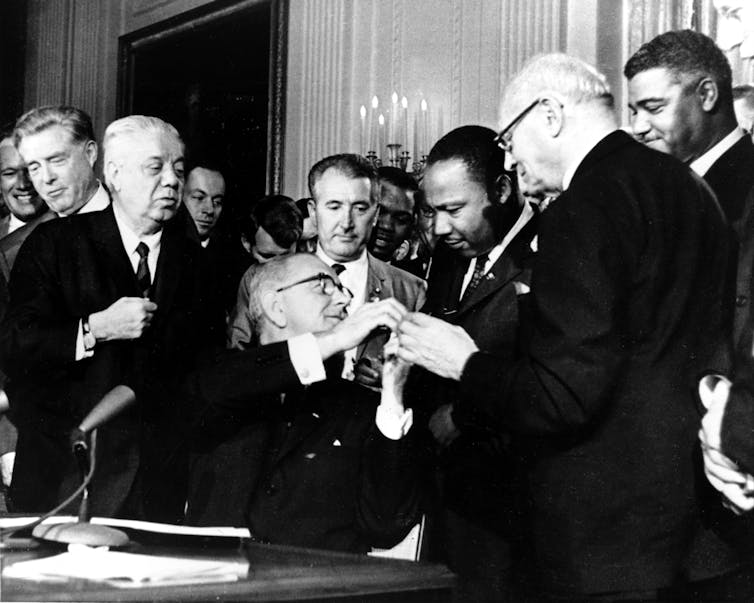Ensuring racial equality – from classrooms to workplaces – depends on federal regulations Trump could roll back
- Written by Derek W. Black, Professor of Law, University of South Carolina
The Trump administration is considering eliminating[1] one of the federal government’s most basic tools[2] for preventing racial discrimination.
When the government runs or funds programs, those programs are obligated to ensure that everyone gets equal access and treatment. This duty comes from something called “disparate impact regulations.” These regulations require the programs to pay careful attention to whether their policies cause racial disparities.
From my perspective as a scholar of discrimination law, abandoning these regulations would be a major departure from the federal government’s mission[3] since the 1960s of ensuring racial equality.
Historical roots
 U.S. President Lyndon B. Johnson reaches to shake hands with Dr. Martin Luther King Jr. after presenting the civil rights leader with one of the 72 pens used to sign the Civil Rights Act of 1964
AP Photo[4]
U.S. President Lyndon B. Johnson reaches to shake hands with Dr. Martin Luther King Jr. after presenting the civil rights leader with one of the 72 pens used to sign the Civil Rights Act of 1964
AP Photo[4]
In the 1950s and 60s, civil rights advocates challenged racial segregation and inequality in every facet of public life – from schools, buses and bathrooms to employment, housing and restaurants. Congress passed the Civil Rights Act of 1964[5] to stamp out as much of that discrimination as possible, prohibiting discrimination in all those areas and more.
But Congress went beyond just prohibiting “discrimination.” It recognized that prohibiting policies with obvious or explicit intent to discriminate was not enough to ensure equality.
Following Congress’s lead, the Department of Justice concluded in a 1966 report[6] that policies that impact one racial group more than another should also be prohibited. Numerous other agencies agreed and put in place[7] what we now call “disparate impact regulations.”
The fact that some policy or practice disproportionately affects a racial group does not alone violate the regulations. The disparity, if serious enough, simply triggers further investigation by a federal agency. That investigation involves two key additional questions.
First, does the program have a good reason, or “legitimate justification[8],” for the policy that is causing the racial disparities? If not, the agency can block the policy because the disparities are unjustified.
But if the program has a good reason, which it often does, the second question is: Can an alternative policy achieve the program’s goals without producing egregious racial disparities? If so, the program should pursue the less discriminatory alternative[9] because the disparities are clearly unnecessary.
Regulations matter
Today, discrimination and inequality continue largely due to subconscious racial biases[10]. These biases are rampant[11] and affect everything from who gets a job[12] to who gets suspended[13] from school.
These regulations alleviate the need to dig into individuals’ minds and search for very difficult to prove[14] racial motives. These regulations, like in decades past, further racial equality by asking that officials justify disparities and pursue alternative policies when possible.
For instance, a 2014 report from the U.S. Department of Education found that schools were suspending and expelling African-Americans more than three times as often[15] as white students. Most of the time it was for minor misbehavior[16]. While racial bias often plays a role in these disparities, federal agencies focused[17] on the negative long-term consequences of school exclusion – consequences that are unnecessary.
The Department of Education asked districts, when possible, to pursue alternatives that would bring down disparities and still maintain school order. This could include programs that prevent misbehavior before it occurs – like student behavioral supports and staff training. Schools that implemented those alternatives saw misbehavior and school exclusion drop[18], and saw academic achievement increase[19]. Agencies’ ability to push this change rested solely on the power given to them by disparate impact regulations.
Why now?
Critics, including the Trump administration, claim that disparate impact regulations impose an undue burden[20] on federally funded programs. They say the regulations force programs to focus too much on analyzing data and avoiding statistical anomalies[21]. Implicit in this claim is that racial discrimination and inequality are no longer widespread problems.
But disparate impact was never just about data, and discrimination was never fully eliminated. To the contrary, data shows discrimination has not declined in the past 25 years[22].
Given the evolution of discrimination and the persistence of gross racial inequities[23], these regulations remain as important today as ever.
References
- ^ considering eliminating (www.washingtonpost.com)
- ^ most basic tools (www.law.cornell.edu)
- ^ federal government’s mission (scholarship.law.georgetown.edu)
- ^ AP Photo (www.apimages.com)
- ^ Civil Rights Act of 1964 (www.justice.gov)
- ^ concluded in a 1966 report (cdn.loc.gov)
- ^ put in place (www.govinfo.gov)
- ^ legitimate justification (www.justice.gov)
- ^ less discriminatory alternative (www.justice.gov)
- ^ racial biases (kirwaninstitute.osu.edu)
- ^ rampant (kirwaninstitute.osu.edu)
- ^ job (fortune.com)
- ^ suspended (www.nytimes.com)
- ^ difficult to prove (papers.ssrn.com)
- ^ three times as often (ocrdata.ed.gov)
- ^ minor misbehavior (papers.ssrn.com)
- ^ focused (www2.ed.gov)
- ^ drop (www.koi-education.com)
- ^ achievement increase (www.educationworld.com)
- ^ undue burden (www.nationalreview.com)
- ^ statistical anomalies (edexcellence.net)
- ^ 25 years (hbr.org)
- ^ racial inequities (news.stanford.edu)
Authors: Derek W. Black, Professor of Law, University of South Carolina

